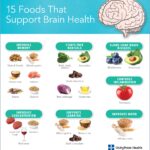Most of us consume far more sodium, commonly known as salt, than our bodies actually need. While salt is essential in small amounts, excessive intake can significantly raise your risk of developing serious health issues, most notably high blood pressure, which in turn can lead to heart disease and stroke. The good news is, taking control of your salt intake is easier than you might think, especially when grocery shopping. By making informed choices, you can significantly reduce the sodium in your diet and enjoy flavorful, healthy meals.
This guide will walk you through how to navigate the grocery store and select delicious Low Salt Foods across all food groups. We’ll empower you to make smarter choices and embrace a healthier, lower-sodium lifestyle without sacrificing taste.
Smart Shopping Strategies for Low Salt Foods
Before diving into specific food categories, let’s establish some fundamental strategies for low-sodium grocery shopping:
-
Prioritize Fresh, Whole Foods: Whenever possible, opt for fresh, unprocessed foods. Processed and pre-packaged foods are often loaded with hidden sodium to enhance flavor and extend shelf life. Fresh fruits, vegetables, and lean proteins are naturally lower in sodium.
-
Become a Nutrition Label Detective: The Nutrition Facts label is your best friend when it comes to monitoring sodium. Pay close attention to the “% Daily Value” (DV) for sodium. Aim for products with 5% DV or less per serving, and be wary of items with 20% DV or more, as these are considered high in sodium.
-
Seek Out “Low Sodium” and “No Salt Added” Labels: Many brands offer “low sodium” or “no salt added” versions of their products. These labels are a quick and easy way to identify lower-sodium options.
Now, let’s explore specific food groups and pinpoint low salt food choices you can confidently add to your shopping cart.
Low Salt Food Champions: Category by Category
Vibrant Vegetables and Fruits
Naturally packed with vitamins, minerals, and fiber, fruits and vegetables are inherently low in sodium powerhouses. Embrace the rainbow and fill your cart with these fantastic options:
- Fresh Fruits: Apples, berries, oranges, mangoes, bananas – the entire fresh fruit aisle is your oyster! Enjoy them as snacks, desserts, or incorporated into meals.
- Fresh Vegetables: Broccoli, sweet potatoes, beets, okra, spinach, peppers, carrots, edamame – a diverse array of fresh vegetables provides endless culinary possibilities and minimal sodium.
- Frozen Vegetables (Plain): Frozen vegetables without added sauces or butter are just as nutritious as fresh and offer convenience without the sodium spike.
- Low Sodium or No Salt Added Canned Vegetables: Canned vegetables can be a pantry staple, but choose “low sodium” or “no salt added” varieties. Rinsing them before use can further reduce sodium content.
- Low Sodium Vegetable Juice: If you enjoy vegetable juice, specifically look for low-sodium versions.
- Frozen, Canned, or Dried Fruits (No Added Sugars): Stock up on these for healthy snacks and recipe ingredients, ensuring no added sugars for optimal health.
Wholesome Whole Grains
Grains are an essential part of a balanced diet, providing energy and fiber. However, even seemingly bland grain products can contribute to your sodium intake. Become a label reader and choose these lower sodium grain options:
- Whole Grains (Unprocessed): Brown rice, wild rice, quinoa, barley, and oats are naturally low in sodium and packed with nutrients.
- Whole Wheat Pasta and Couscous: Opt for whole wheat varieties for added fiber, and ensure they are plain, without added sodium in sauces or flavorings.
- Whole Grain Hot or Cold Cereals (No Added Sugars): Oatmeal and shredded wheat are excellent low-sodium breakfast choices. Avoid sugary cereals which often contain added sodium as well.
- Unsalted Popcorn and Low Sodium Snacks: Air-popped popcorn without added salt is a fantastic low-sodium snack. Look for low-sodium chips and pretzels in moderation.
- Whole Grain Breads, Bagels, English Muffins, Tortillas, and Crackers (Low Sodium): Bread products can be surprisingly high in sodium. Compare labels carefully and choose whole-grain options with lower sodium content per serving.
Protein Powerhouses
Protein is crucial for building and repairing tissues. Choose lean protein sources and be mindful of processed options which are often sodium traps:
- Fresh or Frozen Fish and Shellfish: Naturally low in sodium and rich in omega-3 fatty acids, seafood is an excellent choice.
- Skinless Chicken or Turkey Breast (Unmarinated): Opt for fresh, skinless poultry and avoid pre-marinated or processed chicken products, which are frequently high in sodium.
- Lean Cuts of Beef or Pork: Choose lean cuts and prepare them without adding excessive salt.
- Unsalted Nuts and Seeds: A healthy and satisfying snack, but ensure they are unsalted to keep sodium in check.
- Dried Beans, Peas, and Lentils: Black beans, chickpeas (garbanzo beans), lentils – these are nutritional powerhouses, naturally low in sodium.
- No Salt Added or Low Sodium Canned Beans (Rinsed): If using canned beans, choose “no salt added” or “low sodium” and rinse them thoroughly before use.
- Eggs: A versatile and naturally low-sodium protein source.
Dairy Delights and Alternatives
Dairy products provide calcium and vitamin D, but some can be higher in sodium, particularly cheese. Choose these lower sodium dairy and dairy-free alternatives:
- Fat-Free or Low-Fat Milk (and Lactose-Free Options): Milk is naturally low in sodium.
- Fat-Free or Low-Fat Plain Yogurt: Plain yogurt is a healthy base for breakfasts and snacks. Avoid flavored yogurts, which can have added sugars and sometimes sodium.
- Low Sodium or Reduced Sodium Cheese: Cheese can be a significant source of sodium. Read labels carefully and choose “low sodium” or “reduced sodium” varieties, using them in moderation.
- Fortified Soy Milk or Soy Yogurt: Choose soy milk and yogurt fortified with calcium, vitamin A, and vitamin D as a dairy alternative.
Dressings, Oils, and Condiments: Flavor Without the Salt
These additions can make or break a meal, but many are loaded with sodium. Make smart swaps to keep flavor high and sodium low:
- Unsalted Margarine and Spreads: Choose unsalted margarine or spreads in tubs or liquid form, prioritizing those lower in saturated fat.
- Vegetable Oils: Canola, corn, olive, peanut, safflower, soybean, or sunflower oils are naturally sodium-free.
- Low Sodium Salad Dressing or Oil and Vinegar: Opt for low-sodium salad dressings or make your own using oil and vinegar.
- Low Sodium or “No Salt Added” Ketchup: Look for these lower sodium ketchup options.
- Low Sodium Salsa or Picante Sauce: Enjoy salsa and picante sauce in moderation, choosing low-sodium versions.
Seasoning Sensibly: Beyond the Salt Shaker
Rethink your seasoning strategy! All types of salt, from table salt to sea salt, contribute sodium. Explore these flavorful salt-free alternatives:
- Herbs, Spices, and Salt-Free Seasoning Blends: Experiment with a wide variety of herbs and spices to boost flavor without adding sodium. Salt-free seasoning blends are readily available.
- Fresh Aromatics: Garlic, onions, and peppers add depth of flavor naturally.
- Citrus Zest and Juice: Lemon and lime juice brighten dishes and add zing without sodium.
- Ginger: Fresh or ground ginger adds a warm, spicy note.
Conclusion: Embrace the Low Salt Lifestyle
Reducing your sodium intake doesn’t mean sacrificing flavor. By adopting these smart shopping strategies and embracing naturally low salt foods, you can create delicious and healthy meals while protecting your health. Start small, make gradual changes, and soon you’ll be enjoying the vibrant flavors of food without the unnecessary salt. Your taste buds – and your heart – will thank you!

